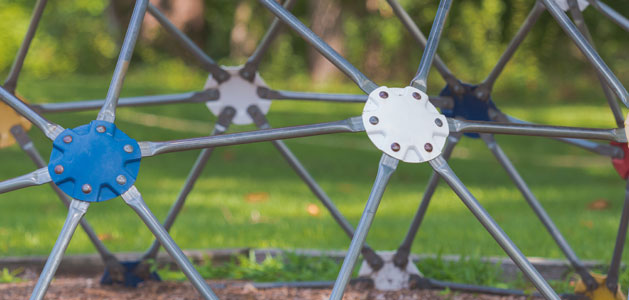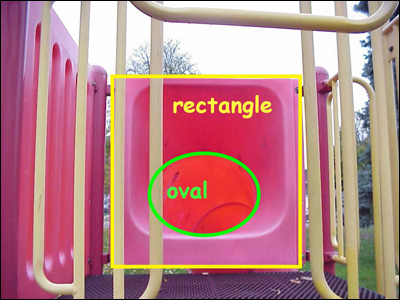
Students learn about 2-dimensional shapes and create a class book identifying these shapes around their school.

Many people think math is just about abstract numbers, but math is everywhere in the world around us. Ask students to help people see math everywhere by creating a book that identifies shapes in the world around them.
Introduce different 2-dimensional shapes to your students. Show your students different examples of squares, circles, rectangles, and triangles and work with them to count the sides and identify them correctly. There are many quality shape videos, like the one below, you can find with a simple online search.
Read a story like The Greedy Triangle by Marilyn Burns or The Shape of Me and Other Stuff by Dr. Seuss to get students thinking about shapes in the world around them.
Ask students to look around your classroom to find objects in your classroom that are a particular shape like a circle or square and to name the shapes that they see. For example, the tables or desks in the room are probably rectangles; the clock is likely to be a circle.
You can use the same process for more advance 2-dimensional shapes like rhombuses and trapezoids or 3-dimensional shapes like cubes and spheres.
Take a walk around your classroom room or school looking for additional shapes in the environment. Playground equipment is a great place for students to find these shapes. Capture images of the shapes you find with a digital camera or an iPad or tablet.

Depending on the age and ability of your students, you can collect the images and put them in a single presentation file. Display the presentation to your students and work together to identify and draw the shapes on it.
If you have Wixie, you can assign this presentation file to the students in your class so they can identify the shapes in the pictures. If students have their access to iPads or tablets, it is easy for them to log in to Wixie, start a new project, and simply add the image from the camera roll.
Have students use paint or drawing tools to identify the shape on the page. Then, have them record their voice identifying the shape and explaining more about it. You may also want to have students describe the shapes location using position words such as on top of, next to, and so on.
Have more advanced students identify complex shapes such as rhombuses and trapezoids, 3D shapes like cubes and spheres, or even acute and obtuse angles.
If you have access to a printer, ask student to print their page or project, so you can hang the images around the room as examples of different shapes students can find in the world around them.
If students created individual pages using Wixie, combine them together using the Project Wizard feature. Print copies of the book for students to take home and share with their families. You can even use the booklet style to print 4 to a page and fold. If students have access to tablets or parent’s smart phones, export the book as a PDF or an ePub file for easy sharing.
Post the project to your classroom web site so you can share the shapes your students found with a classroom in a different part of the country or world. Exchange books and pictures so you can compare the shapes you have each found and use the comparisons to start a discussion about geography, history, and culture.
You can evaluate prior knowledge during your initial conversation about shapes. How easily can students spot shapes in your room? Do they know the names of these shapes? This assessment continues as students move about the room and school finding and capturing additional shapes with a camera or tablet.
A student’s shape page serves as another artifact for assessment, demonstrate their understanding on shape attributes and knowledge of correct terminology.
Marilyn Burns and Gordon Silveria. The Greedy Triangle. ISBN: 0545042208
Dr. Seuss. The Shape of Me and Other Stuff. ISBN: 0679886311
Waterford Central Park: Marmot's Map Shapes Song
CCSS.CONTENT.K.G.A.1
Describe objects in the environment using names of shapes, and describe the relative positions of these objects using terms such as above, below, beside, in front of, behind, and next to.
CCSS.MATH.CONTENT.K.G.A.2.
Correctly name shapes regardless of their orientations or overall size.
CCSS.MATH.CONTENT.K.G.A.3
Identify shapes as two-dimensional (lying in a plane, “flat”) or three-dimensional (“solid”).
CCSS.MATH.CONTENT.2.G.A.1
Recognize and draw shapes having specified attributes, such as a given number of angles or a given number of equal faces. Identify triangles, quadrilaterals, pentagons, hexagons, and cubes.
3. Knowledge Constructor
Students critically curate a variety of resources using digital tools to construct knowledge, produce creative artifacts and make meaningful learning experiences for themselves and others. Students:
d. build knowledge by actively exploring real-world issues and problems, developing ideas and theories and pursuing answers and solutions.
6. Creative Communicator
Students communicate clearly and express themselves creatively for a variety of purposes using the platforms, tools, styles, formats and digital media appropriate to their goals. Students:
d. publish or present content that customizes the message and medium for their intended audiences.

Follow us on Instagram for daily inspiration

Create a thought web, cluster, flowchart, or other graphic organizer for a lesson
Five ideas for creative classroom centers
Creative, digital book reviews
Fun and powerful ideas with animated characters

Wixie
Share your ideas, imagination, and understanding through writing, art, voice, and video.

Rubric Maker
Create custom rubrics for your classroom.

Pics4Learning
A curated, copyright-friendly image library that is safe and free for education.

Wriddle
Write, record, and illustrate a sentence.

Get creative classroom ideas delivered straight to your inbox once a month.
Topics